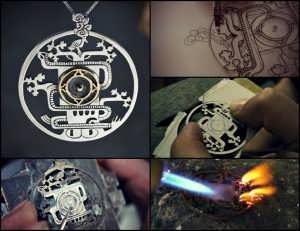The Mayan World Tree
Part of our Mother’s day special – https://goo.gl/sbwOxN
The World Tree, is a very widespread motif in the pre-Columbian Americas. It appears often in Creation myths, in the ancient cosmology and as an important iconographic element in the artwork of varied cultures across America. The use of the tree as a cosmic symbol exists on a wide and diverse scale in cultures from the Viking World Tree (Yggdrasill) – as well as in the Jewish Tree of Sephirot. The Mayan World Tree represents the four directions of the world, where the tree itself is the center -The Mondi axis is the point where earth and sky meet with the perpendicular and horizontal axis of the world.
The symbol originates from the world view that aspires towards logical order in the chaotic Universe. This understanding creates an ordered microcosmos where there is a defined center. From the center, we can turn to each of the cardinal directions in search of knowledge, wisdom and new discoveries. However , outside of this world, there is chaos, night and death.
The image of the tree represents the symbolic axis that unites the three plains: The sky (branches), the earth (the trunk) and the lower world (the roots). Every object that is hanging on the tree represents the tension between the lower world and the upper world and in this way turns into a very strong symbol of the storehouse of knowledge and wisdom. Often, in Mayan art, there are images of birds sitting on the tree representing an ancient father, while the tree’s roots are in the water- a symbol of the underworld. In the Mayan culture, the world tree is represented by the Ceiba tree. This is a tree with a thorny trunk that resembles the skin of an alligator. In fact, the trunk of the tree is described as an alligator standing erect.
Silver Version – https://goo.gl/m53LYq
Gold Version – https://goo.gl/wQUhBG
Silver and Gold Version – https://goo.gl/DrrPvQ

Related Posts
Plant a treeIf there is anything we can do for the earth it is planting trees and…
Plant a treeIf there is anything we can do for the earth it is planting trees and…
Plant a treeIf there is anything we can do for the earth it is planting trees and…
Plant a treeIf there is anything we can do for the earth it is planting trees and…
Plant a treeIf there is anything we can do for the earth it is planting trees and…
Plant a treeIf there is anything we can do for the earth it is planting trees and…
Plant a treeIf there is anything we can do for the earth it is planting trees and…
Plant a treeIf there is anything we can do for the earth it is planting trees and…
Plant a treeIf there is anything we can do for the earth it is planting trees and…
Plant a treeIf there is anything we can do for the earth it is planting trees and…
Plant a treeIf there is anything we can do for the earth it is planting trees and…
Plant a treeIf there is anything we can do for the earth it is planting trees and…
Plant a treeIf there is anything we can do for the earth it is planting trees and…
Plant a treeIf there is anything we can do for the earth it is planting trees and…
Plant a treeIf there is anything we can do for the earth it is planting trees and…
Plant a treeIf there is anything we can do for the earth it is planting trees and…
Plant a treeIf there is anything we can do for the earth it is planting trees and…
Plant a treeIf there is anything we can do for the earth it is planting trees and…
Plant a treeIf there is anything we can do for the earth it is planting trees and…
Plant a treeIf there is anything we can do for the earth it is planting trees and…
Plant a treeIf there is anything we can do for the earth it is planting trees and…
Plant a treeIf there is anything we can do for the earth it is planting trees and…
Plant a treeIf there is anything we can do for the earth it is planting trees and…
Plant a treeIf there is anything we can do for the earth it is planting trees and…
Plant a treeIf there is anything we can do for the earth it is planting trees and…
Plant a treeIf there is anything we can do for the earth it is planting trees and…
Plant a treeIf there is anything we can do for the earth it is planting trees and…
Plant a treeIf there is anything we can do for the earth it is planting trees and…

